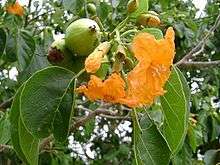Cordia subcordata
Cordia subcordata is a species of flowering tree in the borage family, Boraginaceae, that occurs in eastern Africa, South Asia, Southeast Asia, northern Australia and the Pacific Islands.[2] The plant is known by a variety of names including beach cordia, sea trumpet, and kerosene wood, among others.
| Cordia subcordata | |
|---|---|
 | |
| Flower, fruit | |
| Scientific classification | |
| Kingdom: | Plantae |
| Clade: | Tracheophytes |
| Clade: | Angiosperms |
| Clade: | Eudicots |
| Clade: | Asterids |
| Order: | Boraginales |
| Family: | Boraginaceae |
| Genus: | Cordia |
| Species: | C. subcordata |
| Binomial name | |
| Cordia subcordata | |
Names
Other names for the species include kanawa, tou, kou, mareer, manjak, snottygobbles, glueberry, narrow-leafed bird lime tree, In Java and Madura, it is known as kalimasada, purnamasada, or pramasada; Javanese folklore consider the tree to contain spiritual power.[3] In the Marshall Islands it is known as kono.[4]
Description
C. subcordata grows to 7–10 m (23–33 ft) at maturity, but may be as tall as 15 m (49 ft). It has ovate leaves that are 8–20 cm (3.1–7.9 in) and 5–13 cm (2.0–5.1 in) wide.[5]
Flowers
The tubular flowers of C. subcordata are 2.5–4 cm (0.98–1.57 in) in diameter and form cymes or panicles.[5] Petals are orange and the sepals are pale green. Blooming occurs throughout the year, but most flowers are produced in the spring.[6]
Fruit
C. subcordata produces fruit year round. They are spherical, 2–3 cm (0.79–1.18 in) long, and woody when mature. Each fruit contains four or fewer seeds that are 10–13 mm (0.39–0.51 in) long. The fruit are buoyant and may be carried long distances by ocean currents.[5]
Habitat
C. subcordata is a tree of the coasts, found at elevations from sea level to 30 m (98 ft), but may grow at up to 150 m (490 ft). It grows in areas that receive 1,000–4,000 mm (39–157 in) of annual rainfall. C. subcordata prefers neutral to alkaline soils (pH of 6.1 to 7.4), such as those originating from basalt, limestone, clay, or sand. Allowable soil textures include sand, sandy loam, loam, sandy clay loam, sandy clay, clay loam, and clay.[5]
Uses
The seeds are edible and have been eaten during famine. C. subcordata burns readily, and this led to the nickname of "Kerosene Tree" in Papua New Guinea.[5] The wood of the tree has a specific gravity of 0.45, is soft, durable, easily worked,[6] and resistant to termites. In ancient Hawaiʻi kou wood was used to make ʻumeke (bowls), utensils, and ʻumeke lāʻau (large calabashes) because it did not impart a foul taste to food. ʻUmeke lāʻau were 8–16 litres (2–4 gal) and used to store and ferment poi. The flowers were used to make lei, while a dye for kapa cloth and aho (fishing lines) was derived from the leaves.[5]
In the western Solomon Islands, in Vanuatu, on Waya Island, and in Tonga, it is used for carving. On New Ireland, its wood is always used for the ceremonial entrances to men's houses.[7]
References
- World Conservation Monitoring Centre (1998). "Cordia subcordata". IUCN Red List of Threatened Species. 1998: e.T33199A9761041. doi:10.2305/IUCN.UK.1998.RLTS.T33199A9761041.en.
- "Cordia subcordata". Germplasm Resources Information Network (GRIN). Agricultural Research Service (ARS), United States Department of Agriculture (USDA). Retrieved 2 March 2010.
- Bosbouwproefstation (1936). Korte mededeelingen - Cordia Subcordata. Cornell University. p. 107. Retrieved 30 May 2015.
- http://biormi.org/index.shtml?en/native_plants.shtml. Retrieved 7 September 2019. Missing or empty
|title=(help) - Friday, J. B.; Dana Okano (April 2006). "Cordia subcordata (kou)" (PDF). The Traditional Tree Initiative. Retrieved 21 February 2009. Cite journal requires
|journal=(help) - Allen, James A. (1 January 2003). "Cordia subcordata Lam". Tropical Tree Seed Manual. Reforestation, Nurseries & Genetics Resources. Archived from the original (PDF) on 16 January 2009. Retrieved 24 February 2009.
- Pawley, Andrew; Osmond, Meredith (eds). 2008. The lexicon of Proto Oceanic: The culture and environment of ancestral Oceanic society. Volume 3: Plants. Pacific Linguistics 599. Canberra: Pacific Linguistics, Australian National University.
External links
![]()
![]()
- "Cordia subcordata". FloraBase. Western Australian Government Department of Parks and Wildlife.

